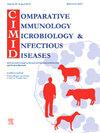Molecular prevalence, phylogenetic analysis, and PCR-based detection of Brucella melitensis in humans and cattle in Southern Khyber Pakhtunkhwa, Pakistan
IF 2
3区 农林科学
Q4 IMMUNOLOGY
Comparative Immunology Microbiology and Infectious Diseases
Pub Date : 2024-10-28
DOI:10.1016/j.cimid.2024.102262
引用次数: 0
Abstract
Brucellosis is a bacterial disease due to Brucella melitensis, considered a zoonotic agent affecting humans and animals, especially in areas with high disease occurrence, south Khyber Pakhtunkhwa, Pakistan. This work was designed to evaluate the molecular rate of B. melitensis in humans and cattle species and also to perform a phylogenetic analysis between both species. A cross-sectional survey involving 800 participants, including 600 cattle and 200 human participants, underwent blood sample collection with conventional PCR and IS711 locus PCR amplification and Sanger sequencing. The findings detected Brucella melitensis in 37 of the 800 samples, with a molecular prevalence of 3.1 % in cattle and 9 % in humans. The molecular trees play a role in zoonotic transmission and point to the necessity of a further unified approach toward the management of brucellosis in both humans and animals. This is further backed by the use of 95 % C.I for the prevalence rates making the results statistically robust. This research shows that using the IS711 insertion sequence is an efficient and selective method for identifying Brucella species.
巴基斯坦南开伯尔-普赫图赫瓦省人和牛中布鲁氏菌的分子流行率、系统发育分析和基于 PCR 的检测
布鲁氏菌病是一种由布鲁氏菌引起的细菌性疾病,被认为是一种影响人类和动物的人畜共患病,尤其是在巴基斯坦开伯尔-普赫图赫瓦省南部等疾病高发地区。这项工作旨在评估布鲁氏菌在人类和牛类中的分子率,并对这两个物种进行系统发育分析。通过常规 PCR 和 IS711 位点 PCR 扩增以及 Sanger 测序,对 800 名参与者(包括 600 头牛和 200 名人类参与者)进行了血样采集。结果在 800 份样本中的 37 份中检测到了布鲁氏菌,牛的分子流行率为 3.1%,人的分子流行率为 9%。分子树在人畜共患病传播中发挥了作用,并指出有必要进一步统一人和动物布鲁氏菌病的管理方法。使用 95 % C.I 表示流行率,使结果在统计上更加可靠。这项研究表明,使用 IS711 插入序列是鉴定布鲁氏菌的一种有效且有选择性的方法。
本文章由计算机程序翻译,如有差异,请以英文原文为准。
求助全文
约1分钟内获得全文
求助全文
来源期刊
CiteScore
4.60
自引率
0.00%
发文量
102
审稿时长
40 days
期刊介绍:
Comparative Immunology, Microbiology & Infectious Diseases aims to respond to the concept of "One Medicine" and to provide a venue for scientific exchange. Based on the concept of "Comparative Medicine" interdisciplinary cooperation between specialists in human and animal medicine is of mutual interest and benefit. Therefore, there is need to combine the respective interest of physicians, veterinarians and other health professionals for comparative studies relevant to either human or animal medicine .
The journal is open to subjects of common interest related to the immunology, immunopathology, microbiology, parasitology and epidemiology of human and animal infectious diseases, especially zoonotic infections, and animal models of human infectious diseases. The role of environmental factors in disease emergence is emphasized. CIMID is mainly focusing on applied veterinary and human medicine rather than on fundamental experimental research.

 求助内容:
求助内容: 应助结果提醒方式:
应助结果提醒方式:


